The Most Critical Tool In a Modern Call Center
In the world of customer service, every interaction can make or break a business relationship, and call centers stand at the front lines. But what if I told you that the most critical tool in a call center’s arsenal isn’t the latest headset technology or a cutting-edge CRM system? It’s far more nuanced and powerful: conversation intelligence enhanced with sentiment analysis.
While many businesses focus on quantitative metrics like call duration and resolution rates, they often overlook the goldmine of qualitative data hidden within each customer interaction. This oversight is costs companies more than they realize – in missed opportunities, customer churn, and untapped innovation potential.
In this post, we’ll explore why conversation intelligence with sentiment analysis isn’t just another software tool, but a transformative force that’s reshaping the very DNA of customer service. We’ll delve into its unexpected applications, challenge some common misconceptions, and uncover how it’s quietly revolutionizing businesses from the inside out.
What is Conversation Intelligence?
At its core, conversation intelligence is the ability to analyze and derive meaningful insights from spoken or written communications. But let’s be clear: we’re not talking about simple speech-to-text conversion or keyword spotting. Those are important, but not what gives your call center an edge.
Modern conversation intelligence is akin to having a team of expert linguists, psychologists, and data scientists listening to every call, picking up on subtle nuances, unspoken sentiments, and underlying patterns. It’s about understanding the ‘why’ behind the ‘what’ in customer communications.
Here’s where it gets interesting:
- Contextual Understanding: Unlike traditional systems that might flag certain words as positive or negative, advanced conversation intelligence understands context. Once dialed in, conversation intelligence software can detect emotions through context and differentiate between the tone in the same phrase, spoken with different inflections.
- Predictive Capabilities: Imagine a system that not only analyzes current conversations but predicts future outcomes. It can forecast which customers are likely to churn based on subtle changes in their communication patterns over time.
- Cross-Channel Synthesis: In today’s omnichannel world, conversation intelligence doesn’t stop at phone calls. It synthesizes data from emails, chats, social media interactions, and even video calls to provide a holistic view of customer communication.
- Cultural and Linguistic Adaptability: Advanced systems can adapt to or allow users to adjust for regional dialects, cultural nuances, and even industry-specific jargon, providing accurate insights across diverse customer bases.
The Role of Sentiment Analysis

Sentiment analysis is often misconstrued as a simple positive/negative classifier. In reality, when integrated with emotion detection features into conversation intelligence, it becomes a sophisticated emotional barometer capable of detecting and interpreting a spectrum of human emotions.
Here’s how sentiment analysis is breaking new ground:
- Emotional Intensity Mapping: Beyond identifying whether a sentiment is positive or negative, modern systems can gauge the intensity of emotions. This allows businesses to prioritize responses based on the urgency of emotional states.
- Sentiment Trajectory Analysis: It’s not just about the final sentiment, but how it evolved throughout the conversation. Did a customer start frustrated but end satisfied? This trajectory can be more telling than the end state alone.
- Multimodal Sentiment Analysis: Cutting-edge systems don’t just analyze words. They incorporate tone of voice, speech rate, and other cues to provide a more accurate sentiment assessment.
- Contextual Sentiment Understanding: The same words can carry different sentiments in different contexts. For instance, “This is crazy!” could be positive in response to an amazing offer, but negative when describing a complicated process.
- Sarcasm and Irony Detection: One of the hardest nuts to crack in sentiment analysis, but technology is evolving to better detect subtle linguistic cues that indicate sarcasm or irony, preventing misinterpretation of customer intent.
By combining the depth of conversation intelligence with the nuanced understanding provided by advanced sentiment analysis, businesses gain access to an unprecedented level of customer insight. This potent combination doesn’t just inform decision-making; it revolutionizes the entire customer service paradigm.
In the sections that follow, we’ll explore how this technology is reshaping call centers, elevating customer experiences, and driving business growth in ways that were unimaginable just a few years ago.
Benefits for Call Centers: Beyond the Obvious
When discussing the benefits of conversation intelligence and sentiment analysis for call centers, many articles rehash the same points about improved efficiency and customer satisfaction. While these are undoubtedly important, let’s delve into some less obvious, yet potentially game-changing advantages:
- Proactive Issue Resolution:
Most call centers react to customer issues. With advanced conversation intelligence, you can predict and prevent them. By analyzing patterns in customer interactions across thousands of calls, the system can identify emerging issues before they become widespread problems. This shifts the paradigm from reactive to proactive customer service. - Emotional Intelligence Training:
Instead of generic customer service training, conversation intelligence provides the tools for personalized emotional intelligence coaching for agents. Using the analysis of successful emotional interactions, managers can create tailored training programs that help agents improve their emotional resonance with customers. - Agent Coaching Guided by Trends
When looking at trends within the calls, supervisors can easily see outliers and pinpoint where the call went wrong. This allows for timely intervention, potentially saving customer relationships before they deteriorate. - Competitive Intelligence:
Customers often mention competitors during calls. Advanced conversation intelligence can aggregate and analyze these mentions, providing valuable insights into competitor strategies, pricing, and customer perception without spending time on separate market research. - Fraud Detection:
By analyzing speech patterns, emotional indicators, and linguistic anomalies, conversation intelligence can flag potential fraudulent calls, adding an extra layer of security to call center operations.
Impact on Customer Experience: The Ripple Effect
The impact of conversation intelligence on customer experience extends far beyond the immediate interaction. Let’s explore some of the ripple effects that are often overlooked:
- Personalization at Scale:
By understanding customer emotions and preferences across multiple interactions, businesses can create hyper-personalized experiences tailored to each individual, even in large-scale operations. - Emotional Journey Mapping:
Instead of focusing solely on customer journey touchpoints, businesses can now map emotional journeys. This allows for the identification and optimization of emotional highs and lows throughout the customer lifecycle. - Cross-channel Emotional Consistency:
With insights from conversation intelligence, businesses can ensure emotional consistency across different channels. The empathetic tone used in a phone call can be mirrored in follow-up emails or chat interactions. - Predictive Emotional Routing:
Advanced systems can help managers route customers to agents not just based on skill, but on emotional compatibility. A customer whose calls have been flagged as showing signs of frustration might be routed to an agent who excels at defusing tense situations. - Empathy-Driven Product Development:
Insights from conversation intelligence can feed directly into product development. Understanding the emotional pain points of customers can lead to innovations that address not just functional, but emotional needs.
Improving Agent Performance: A Paradigm Shift

Traditional metrics for agent performance often focus on quantitative measures like call handling time or first-call resolution. Conversation intelligence allows for a more nuanced and effective approach:
- Emotional Intelligence Quotient:
Beyond traditional KPIs, agents can be evaluated on their emotional intelligence quotient (EQ), measuring their ability to navigate complex emotional interactions. - Soft-Skill Development:
Instead of broad training programs, conversation intelligence enables the identification and development of soft skills. An agent might excel at opening conversations but struggle with closing. Targeted soft-skill modules can address these specific areas. - More Modern Coaching:
Modern coaching techniques should include the tools managers use as well. Emotion detection and sentiment analysis are unbiased tools managers can use to provide suggestions to agents based on the emotional context of the conversation. This “emotional co-pilot” can help even novice agents navigate complex interactions. - Peer Learning Networks:
By the same token, managers can analyze successful emotional interactions across agent teams. Then managers can facilitate peer learning networks, strategically connecting agents who can learn from each other’s strengths. - Burnout Prevention:
By monitoring the emotional toll of interactions on agents over time, the system can alert managers to potential burnout situations before they impact performance or lead to turnover.
Data-Driven Decision Making: Emotions as Business Intelligence
While data-driven decision-making is not new, incorporating emotional data from conversation intelligence opens up new avenues for strategic insights:
- Emotional Impact on Lifetime Value:
By correlating customer emotions over time with their lifetime value, businesses can quantify the financial impact of positive emotional experiences. - Sentiment-Based Product Positioning:
Understanding the emotional responses to different product features can inform not just product development, but how products are positioned and marketed. - Emotional Trend Forecasting:
By analyzing shifts in customer sentiment over time, businesses can forecast emerging trends and adapt strategies proactively. - Crisis Prediction and Management:
Subtle shifts in aggregate customer sentiment can be early indicators of potential crises, allowing for proactive management strategies. - Emotion-Driven Pricing Strategies:
Understanding the emotional perceived value of products or services can inform more nuanced and effective pricing strategies.
In the next sections, we’ll explore implementation challenges, ROI considerations, and future trends in this rapidly evolving field.
Implementation Challenges and Solutions: Navigating the Emotional Landscape
While the benefits of conversation intelligence with sentiment analysis are compelling, implementation isn’t without challenges. Let’s explore some less-discussed hurdles and innovative solutions. Since we are most familiar with our solution, we will focus on how CallFinder helps call centers overcome these challenges, from CallFinder’s seamless tech integration to our unique managed client services.

- Emotional Data Privacy:
Challenge: As we delve deeper into emotional analysis, we enter a grey area of data privacy. How much emotional data is ethical to collect and analyze?
Solution: CallFinder is a SOC 2-compliant solution, which means that we have the appropriate controls in place to mitigate risks related to security, confidentiality, and privacy. We apply both application and user-level protections to prevent users from accessing confidential information. Learn more about our privacy policy. - Cross-Cultural Emotional Intelligence:
Challenge: Emotions are expressed and interpreted differently across cultures, making global implementation complex.
Solution: CallFinder has a unique advantage over our competitors. We offer a managed solution, which means that every client is assigned a CallFinder Speech Analyst to help you adjust emotional interpretation based on cultural context. Collaborate with your team to create culture-specific emotional models. - The Uncanny Valley of Empathy:
Challenge: As AI becomes more emotionally intelligent, there’s a risk of creating interactions that feel almost human, but not quite, potentially leading to customer discomfort.
Solution: Embrace “AI-human fusion” models where AI augments human agents rather than replacing them. Clearly disclose AI involvement in emotional analysis to maintain transparency and trust. - Emotional Data Overload:
Challenge: With the ability to analyze every emotional nuance, organizations risk paralysis by analysis.
Solution: Develop “sentiment and emotion KPIs” that distill complex emotional data into actionable metrics. - Resistance to Emotional Metrics:
Challenge: Traditional call center managers may resist shifting from time-based metrics to emotional effectiveness metrics.
Solution: With CallFinder, you can be as transparent as you want with your team. Scorecards, transcriptions, and reports can be shared with any user to help integrate traditional KPIs with new emotional metrics. This will help provide employee training on the business impact of emotional intelligence to drive organizational buy-in.
ROI and Business Impact: Quantifying the Intangible
Measuring the ROI of conversation intelligence and sentiment analysis requires looking beyond traditional metrics. In particular, here are a few ways that forward-thinking organizations are quantifying the impact:
- Emotional Lifetime Value (E-LTV):
Move beyond Customer Lifetime Value to calculate Emotional Lifetime Value. This metric factors in the cumulative impact of positive emotional experiences on customer longevity and spending. - Sentiment Volatility Index:
Develop a Sentiment Volatility Index that tracks the stability of customer emotions over time. Lower volatility often correlates with higher customer retention and predictable revenue streams. - Empathy Efficiency Ratio:
Calculate the Empathy Efficiency Ratio by measuring the positive emotional outcomes against the time and resources invested in customer interactions. This helps optimize the balance between efficiency and emotional effectiveness. - Brand Emotion Equity:
Quantify Brand Emotion Equity by aggregating positive emotional experiences and their ripple effects on brand perception, word-of-mouth marketing, and customer acquisition costs. - Predictive Churn Emotions:
Identify specific emotional patterns that are precursors to churn. Quantify the ROI of intervention strategies based on these emotional early warning systems.
Future Trends: The Next Frontier of Conversation Intelligence
As we look to the future, several emerging trends promise to revolutionize conversation intelligence and sentiment analysis in call centers:
- Understanding Complex Emotions:
As conversation intelligence technology advances, call center managers can analyze various emotional states; this provides a more nuanced understanding of complex, seemingly contradictory emotions. - Neuro-Linguistic Programming (NLP) Integration:
Advanced technology can pick up trends and conversation patterns to match and positively influence customer emotional states. - Emotional Cues Mapping:
To help agents with empathetic interactions, cues about customer emotions allow for more intuitive emotional navigation of conversations. - Predictive Emotional Journey Design:
With the right approach, call center managers and leaders can design optimal emotional journeys for customers, orchestrating touchpoints across various channels to create peak emotional experiences. - Coaching Modules That Teach Agents to Show Empathy:
AI-fueled conversation intelligence with sentiment provides the ability to pick up on subtleties in voice, such as tone and pitch. With the right tools, managers can easily enhance coaching modules.
Conclusion: The Emotional Intelligence Revolution

As we’ve explored throughout this post, conversation intelligence with sentiment analysis is far more than just another tool in the call center software suite. It represents a fundamental shift in how businesses understand and interact with their customers on an emotional level.
By moving beyond simplistic sentiment categorization to deep, contextual emotional understanding, businesses can create truly empathetic customer experiences at scale. This technology doesn’t just improve call center metrics; it has the potential to transform the entire customer relationship paradigm.
The organizations that will thrive in the coming decades will be those that embrace this technology. Additionally, they will use it to cultivate genuine emotional intelligence throughout their operations. They will be the ones who see customers not just as data points, but as complex emotional beings, and who use that understanding to create meaningful, lasting connections.
As we stand on the brink of this emotional intelligence revolution, one thing is clear: the most critical asset a business can have is the ability to hear its customers. However, to truly understand and empathize with them, organizations need solutions like conversation intelligence with sentiment analysis. Not only that, but it’s the key to unlocking the future of customer relationships.
If you want to learn more about how CallFinder can help your call center with conversation intelligence, schedule a quick demo.











